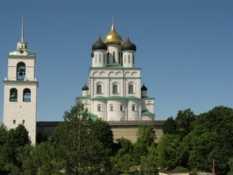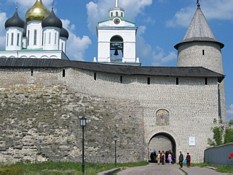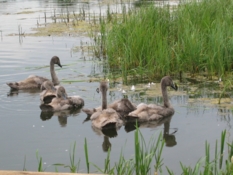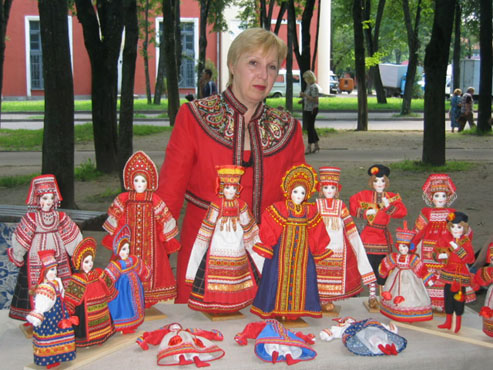


 Pskov City tours. The Pskov Region
Pskov City tours. The Pskov Region
 A very warm welcome and hope you enjoy your visit to
Pskov.
A very warm welcome and hope you enjoy your visit to
Pskov.
There are two professional theatres in Pskov - Pushkin Drama Theatre and Puppet Theatre. Our Theatres: fun and pleasure for all who stay young at heart.
The picturesque nature, plenty of forests, rivers, lakes create the perfect conditions for rest. Walk and fill your lungs with fresh air, enjoy the green silence and grand views. Enjoy a romantic sunsets that touch your soul. Imagine being able to concentrate on revitalizing the passions of what's truly important to you.
City tour (Duration - 3 hours).
Pskov is very ancient Russian city and attracts numerous tourists. You can examine the remains of ancient fortress walls, modest and magnificent churches, ancient merchant houses. The ancient Kremlin arose on a narrow cliff at the confluence of the Velikaya and Pskova Rivers. It was built by the gifted architects of Pskov. During many centuries of its existence the Kremlin was reconstructed for a few times. But even nowadays its mighty walls and towers make a great impression. Pskov start its history from this place that is why the best way to get to know Pskov is to begin sightseeing from the Kremlin. There are many churches in Pskov. You can visit Kremlin with beautiful Trinity Cathedral, 17th century. There you can see 7 tier iconostasis. During the tour you will get acquainted with the peculiar features of the Pskovian religious and secular architecture, as well as the architecture of fortifications. The most brilliant samples of the Pskov architectural school are the Churches of St. Nicholas on Usokha (16th century) and St. Basil on the Hill (15th century), the Pogankin House (17th century), the Intercession complex (16th century).
Historical and Fine Arts Museum.
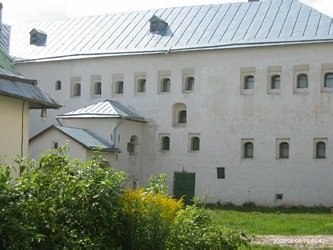 (Duration - 2 hours).
(Duration - 2 hours).
One can visit Museum of History and Fine Arts Pogankin Chambers. There are "Icons", "Picture Gallery", "Silver", "Armory" departments in the museum. Most exhibitions of the museum are located in the best-known secular building of Pskov - the famous
Pogankin house, called
"chambers". In the 17th century the chambers belonged to one of the richest merchant families in Pskov - the Pogankins. The museum possesses the unique collections of the silverwork (14-19th century) and the icons of the Pskov icon-painting school (14-17th century). The archaeological division is of noteworthy interest, as well as the exhibition of the applied art (18-20th century) and the picture gallery. The collection of the museum includes about 500 000 items.
Mirozhsky Monastery
(Duration - 1.5 hours).
We have very ancient Mirozhsky Monastery of the 12th century. The world famous frescoes 12 century of its Cathedral of the Transfiguration occupy an important place in the history of Russian and world culture.
Mirozhsky monastery was founded in the 12th
century. Mirozhsky Monastery situated on the left bank of Velikaya (Great) river. It not only was the most ancient and one of the richest monasteries in Pskov, but also a significant cultural center. It took a few centuries to construct the monastery buildings. The most ancient of them, the Cathedral of the Transfiguration of Our Savior, was commissioned by the Archbishop Niphont of Novgorod and built in the 12th century. On the architectural style the Cathedral differs from all the churches not only in Pskov, but also in entire Ancient Russia. Niphont, who was of Greek origin, wished to built a church according to the Byzantine pattern in Russia.
The walls of the Cathedral of the Transfiguration of our Savior are decorated with the frescos. They were painted by the Byzantine artists in the middle of the 12th century. 80 % of the original frescos have survived. Mirozhsky monastery is included in the UNESCO list of the most outstanding architectural landmarks of the world.
Izborsk and Pechory
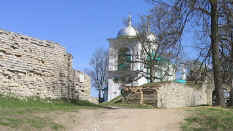 (Duration - 6 hours).
(Duration - 6 hours).
Under Izborsk's fortress (9 century) there still flow springs, called "the Slavensky
springs". It is wonderful springs of Youth, a Love and Beauty. Outdoors,
Izborsk's beauty and diversity offer fun for every season. There are still ancient caves in the Pechorsky ancient Monastery. Izborsk fortress is located 32 km west of Pskov. In The Tale of Bygone Years - the most outstanding literary work of Kievan Russia - Izborsk was mentioned in one of the first chapters, when in 862 three Varangian princes were asked by the Slavs to rule over their towns. One of them, Truvor, became a prince of Izborsk. In the 14-16th centuries
Izborsk was a reliable outpost of Pskov, its "younger brother". The perfectly preserved Izborsk fortress had to withstand 8 long sieges from the 14th to the 16th century and was never captured by enemy. Sightseeing in
Izborsk will not be complete if you do not have a look at its ancient buildings. The Church of St. Sergius (16th century) is the most interesting among them. Now it houses a museum of the archaeological finds. The ethnographical complex Peasant Farmstead was recently opened in Izborsk. Here you can
taste Russian traditional dishes cooked according to the old Izborsk
recipes.
Pechory (20 km of Izborsk, 52 km of Pskov) is a tiny neat town, located on the very Estonian border. Its main attraction is Pskov's Monastery of the
Caves. Founded in 1473, the monastery has never been closed. The magnificent architectural ensemble of the monastery was formed over many centuries, and nowadays its extraordinary beauty makes a great impression on everyone who comes here for the first time. The perfectly preserved powerful fortress of the 16th century was an impregnable outpost in the western part of the Russian state. At the same time, the monastery was one of the largest cultural centers of ancient Russia. Chronicles and literary works were written here, as well as priceless samples of Russian painting, applied art and jewelry were made and collected by the monks. The name of the monastery was derived from the Old Russian word "pechera" meaning "cave", as the monastery originated from the caves.
The caves are located in a steep sandy slope of the Kamenets Stream, in a hill that was considered as a holy site since pagan times. Amazing climatic conditions (the constant temperature in the caves is +5°C all the year round) made the caves a convenient refuge for the people who wished to live in solitude away from the distractions of the world. The ancient caves are an enormous burial vault where nearly 10 000 people are buried - monks, worries, statesmen, peasants and townspeople.
The first monastery church was also a cave church. It was sanctified in 1473 in honor of the Dormition according to an ancient tradition. Annually, on August 28 lots of pilgrims and tourists come to the monastery to celebrate its main feast, the Dormition of Virgin Mary.
It only takes 5 minutes to get to the Estonian border from Pechory. If you feel like doing the sights of Izborsk and Pechory during your stay in Estonia, We can help you to receive a one-day visa for entry to Russia. These simplified visas are issued for a party of 8 or more tourists in the Consular office at the Russian-Estonian border point. Visa tax is 12 USD per person. For more details:
Obtaining Russian Visa
As you send us a list of tourist group, where you include name, gender, date of birth, number of passport for each tourist, we prepare a letter of invitation for your group and send it to you. You go to the Russian Embassy with the letter and obtain visas.
The Alexander Pushkin Estate-Museum.
Beautiful natural landscape of that place influenced on Alexander Pushkin
(Duration- 9 hours).
120 km south-east of Pskov there stands the Holy Hills Monastery with its old Cathedral of Dormition (16th century). The greatest Russian poet of the 19th century Alexander Pushkin is buried by its walls not far away from his favorite
Mikhailovskoye estate. It was here in the Pskov countryside that Pushkin's
poetry was moulded and his genius flourished. The wonderful estates of Trigorskoye (the estate of the poet's friends, the Osipov-Wolf family) and Petrovskoye (the estate of Pushkin's great grandfather Abraham Hannibal) were a source of delight and wonder for the poet. At Mikhailovskoye, where Pushkin had to spend "two inconspicuous years living in exile", he wrote over 100 works including the country chapters of his major novel Eugene Onegin, the drama Boris Godunov, the lyrical
poem A Magic Moment I remember… Through all his life, Pushkin carried his passionate love for Mikhailovskoye, where thousands of people come to pay tribute to the poet.
Pskov city location. Past and
Present. >>>
